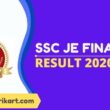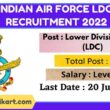UPSC NDA II Exam Notification 2022
Union Public Service Commission (UPSC) released online notification for NATIONAL DEFENCE ACADEMY & NAVAL ACADEMY EXAMINATION (II), 2022. Interested candidates can apply for UPSC NDA II Exam 2022 on or before 07 June 2022. Please go through this sarkari naukri post for UPSC NDA II Exam details, educational qualification, eligibility criteria, Application Fees and How to apply for UPSC NDA II Examination 2022 through online via official website https://upsc.gov.in

UPSC NDA II Exam Notification 2022 : Overview
| Organization Name | Union Public Service Commission (UPSC) |
| Exam Name | NATIONAL DEFENCE ACADEMY & NAVAL ACADEMY EXAMINATION (II), 2022 |
| Total Post | 400 |
| Last Date of Application | 07 June 2022 |
| Job Location | All India |
| Advt. No. | 10/2022-NDA-II |
| Category | Sarkari Naukri |
| Official Website | https://upsc.gov.in |
UPSC NDA II Exam 2022 : Important Dates
| Events | Date |
| Starting Date of Online Application | 18 May 2022 |
| Last Date for Submission of Application Form | 07 June 2022 |
| UPSC NDA II 2022 Exam Date | 04 September 2022 |
UPSC NDA II Exam Notification 2022 : Vacancy Details
| Name of the Course | No. of Vacancies | |
| National Defence Academy (150th Course) | Army | 208 |
| Navy | 42 | |
| Air Force | (i) Flying – 92 (ii) Ground Duties (Tech) – 18 (iii) Ground Duties (Non Tech) – 10 | |
| Naval Academy (10+2 Cadet Entry Scheme) (112th Course) | 30 | |
| Total | 400 | |
UPSC NDA II Exam 2022 : Eligibility Criteria
| Wing | Educational Qualification |
| For Army Wing of National Defence Academy | 12th Class pass of the 10+2 pattern of School Education or equivalent examination conducted by a State Education Board or a University. |
| For Air Force and Naval Wings of National Defence Academy and for the 10+2 Cadet Entry Scheme at the Indian Naval Academy | 12th Class pass with Physics, Chemistry and Mathematics of the 10+2 pattern of School Education or equivalent conducted by a State Education Board or a University. |
UPSC NDA II Exam Notification 2022 : Age Limit
| Age Limit |
| Only unmarried male/female candidates born not earlier than 02nd January, 2004 and not later than 1st January, 2007 |
| (Please refer official notification for further age relaxation) |
UPSC NDA II Exam Notification 2022: Application Fees
| Category | Application Fee |
| UR/ OBC | 100/- |
| SC /ST/ Female Candidates/ Wards of JCOs/ NCOs/ ORs | No Fee |
How to Apply for UPSC NDA II Exam 2022
| Interested candidates who fulfill the eligibility criteria may apply Online through UPSC website www.upsconline.nic.in from 18.05.2022 to 07.06.2022. |
UPSC NDA II Exam Notification 2022 : Selection Process
| Selection will be based on a written test, SSB interview, Intelligence and Personality Test |
UPSC NDA II Exam Notification 2022 : Important Links
| Apply Online | Click Here |
| Official Notification | English | Hindi |
| UPSC Official Website | Click Here |
| Join Our Telegram Channel | Click Here |
| Like our Facebook Page | Click Here |
UPSC NDA II Exam Pattern
| Subject | Duration | Maximum Marks |
| Mathematics | 2½ Hours | 300 |
| General Ability Test | 2½ Hours | 600 |
| Total | 900 | |
| SSB Test/ Interview: | 900 | |
UPSC NDA II Exam 2022 : Syllabus
| PAPER-I MATHEMATICS (Code No. 01) 1. ALGEBRA 2. MATRICES AND DETERMINANTS : 3. TRIGONOMETRY : 4. ANALYTICAL GEOMETRY OF TWO AND THREE DIMENSIONS: 5. DIFFERENTIAL CALCULUS : 6. INTEGRAL CALCULUS AND DIFFERENTIAL EQUATIONS : 7. VECTOR ALGEBRA : 8. STATISTICS AND PROBABILITY : PAPER-II GENERAL ABILITY TEST (Code No. 02) Part ‘A’—ENGLISH (Maximum Marks—200) Part ‘B’—GENERAL KNOWLEDGE (Maximum Marks—400) Section ‘B’ (Chemistry)
Section ‘E’ (Geography) Section ‘F’ (Current Events) Intelligence and Personality Test |
UPSC NDA II Exam2022 : FAQ’s
-
When will notification for UPSC NDA II Exam 2022 be released?
The notification for UPSC NDA II Exam2022 has been released on 18 May 2022.
-
How many vacancies are there in the UPSC NDA II Exam 2022?
There are 400 vacancies in the UPSC NDA II Exam 2022
-
What is the last date to apply for UPSC NDA II Exam 2022?
The last date to apply for UPSC NDA II Exam 2022 is 07 June 2022.
-
What is the official website of UPSC NDA II Exam2022?
https://www.upsconline.nic.in




